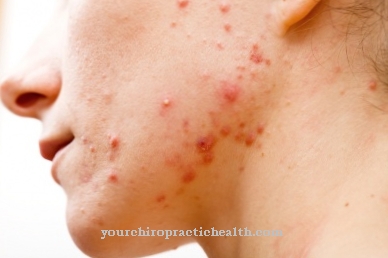Bowen's disease, the precursor of white skin cancer, can be recognized by prominent areas on the skin. Regular follow-up checks or removal of the affected skin can minimize the risk of skin cancer.
What is Bowen's Disease?

© Markus Bormann - stock.adobe.com
As Bowen's disease, also Carcinoma in situ called, is the early stage of white skin cancer.
In Bowen's disease, the cancer cells are so far only located in the top layer of the skin and do not yet appear in the deeper layers of the skin. Bowen's disease was named after the American dermatologist John T. Bowen, who was the first to describe the disease.
Bowen's disease can usually be recognized by itchy, reddened and rough spots on the skin. The spread is limited and usually only occurs in one place.
These wart viruses, or HPV for short, are a chronic infection that can mutate into white skin cancer, a malignant tumor. Bowen's disease occurs mainly in the second half of life. Men are slightly more prone to developing Bowen's disease than women.
causes
Bowen's disease often occurs in conjunction with regular contact with arsenic, tar products, or other cancer-causing chemicals.
Cancer-causing viruses of the type Human Papilloma Virus (HPV) 16, 18, 31, 33, 35 and 45 also play a role in the formation of Bowen's disease.
The decision for Bowen's disease is often also the individual skin type in connection with strong UV radiation over a long period of time. The use of sun protection cream with an insufficient sun protection factor and the lack of protective clothing increase the risk of Bowen's disease.
But genetic factors, X-rays, immunosuppression and trauma can also be a trigger for Bowen's disease.
Symptoms, ailments & signs
Bowen's disease can be diagnosed based on the typical skin changes. This is flat, usually well-defined redness that is easily vulnerable and flaky. They can be itchy and painful, and bleeding if you press or scratch them. The skin defects slowly increase in size and depth and spread over the course to the surrounding body regions.
They are visually reminiscent of psoriasis and are therefore often confused with this disease. As Bowen's disease progresses, the symptoms mentioned increase in intensity, which often leads to psychological complaints. Those affected then develop, for example, depressive moods or social fears (especially if the skin changes occur on the face, arms and genital area).
The conspicuous complexion is mainly seen in areas that are regularly exposed to UV radiation, i.e. on the face, hands and lower legs. The defects can also occur in the groin and anus region, as well as on the penis and vulva. If Bowen's disease is left untreated, it can develop into skin cancer. The skin defects then develop into painful nodules and change in color, shape and size.
Diagnosis & course
Bowen's disease occurs more in middle to old age. Mainly parts of the body that are more frequently exposed to UV radiation are infected with Bowen's disease. The symptoms are usually irregularly shaped, scaly red skin that is prone to itching and crusting or which can develop into small ulcers. The main areas affected, usually on the legs, hands, head or neck, grow in surface and depth over time.
In order to rule out a mix-up with psoriasis and diagnose Bowen's disease, it is necessary to take a skin sample from the affected area of skin. If the disease can be identified as Bowen's disease, the skin should either be checked regularly or the affected tissue should be removed.
Complications
As a rule, complications from Bowen's disease only arise if it is not discovered and treated in good time. In the worst case, this can lead to skin cancer from which the affected person dies. There are changes in different places on the skin. These are usually relatively well demarcated and clearly visible.
The skin is reddened and can become flaky. The skin can also itch and lead to very uncomfortable feelings. It is not uncommon for a late diagnosis of Bowen's disease, as the disease shows symptoms similar to psoriasis and can therefore be confused with this complaint. It is not uncommon for those affected to be ashamed of the symptoms and thus suffer from reduced self-esteem and inferiority complexes.
Treatment of Bowen's disease can take place through various therapies and interventions. With an early diagnosis, the symptoms can usually be limited relatively well so that there are no skin cancer or other complications. The treatment also usually does not reduce or limit the life expectancy of the person affected. However, patients still need regular examinations after treatment.
When should you go to the doctor?
Unusual changes in the appearance of the skin should be presented to a doctor. If they spread on the body or if they increase in intensity, a visit to the doctor is advisable as soon as possible. Pain, itchy, or open wounds are cause for concern. If sterile wound care cannot be guaranteed, a doctor should be consulted. If existing wounds enlarge or pus form, there is an increased risk of sepsis. A doctor should be consulted, as blood poisoning creates a potential danger to life. If you have bleeding from the skin after applying pressure or scratching it lightly, you need to see a doctor. Bowen's disease is characterized by a particular depth of skin changes.
It is therefore advisable to clarify the complaints immediately as soon as the deeper layers of the skin are affected. In most cases, skin regions are affected by changes that are increasingly exposed to sunlight. A doctor should therefore be consulted as soon as sudden irregularities are noticed in the face, neck, décolleté, hands or legs. If the physical complaints also result in mental or emotional abnormalities, a visit to the doctor is also recommended. In the case of persistent mood swings or peculiarities of behavior, the person concerned needs medical help. Fears, depressive moods as well as social withdrawal behavior are signs of a discrepancy that needs to be clarified.
Treatment & Therapy
Instructs a patient Bowen's disease all parts of the body must be thoroughly examined for other affected areas. Occurrences of Bowen's disease should either be checked regularly so that mutations can be detected at an early stage, or they should be removed immediately. In order to remove Bowen's disease as thoroughly as possible, not only the affected uppermost skin layer, but also part of the healthy skin tissue is removed.
As an alternative to surgery, Bowen's disease can also be treated with light therapy, freezing or tumor-destroying creams. However, since this early type of white skin cancer only affects the top layer of skin and the tumor tissue can be easily removed, surgical removal is the preferred treatment option.
Even if the affected skin is removed, there is a good chance that Bowen's disease will return over the next few years. Therefore, after completing a treatment, the skin should be checked at least once a year.
Outlook & forecast
The prognosis depends individually on the timely diagnosis and treatment. Bowen's disease develops malignant tissue on the skin which, if left untreated, can turn into dreaded skin cancer. If the tissue is removed in good time, the prognosis for those affected is good. If it is Bowen's disease and not yet further skin cancer, then the disease has not yet been able to settle any daughter tumors, which promises a good chance of a cure.
Usually the disease can then be completely cured. However, it is still possible that the disease will recur in the same place in those affected. Therefore, patients should regularly see their dermatologist for checks. The prognosis is worse if the tissue changed by the disease has crossed the basement membrane of the skin. Then the disease can spread to other parts of the body of the person affected.
The cancerous tissue can then also have a destructive effect there.If a timely therapy is missed, there is the possibility that Bowen's disease, a so-called spinalioma, can penetrate deeper layers of the affected skin and spread further there. The resulting life-threatening daughter tumors, also known as metastases, spread in this case throughout the body and can attach themselves to various organs and destroy them. Therefore, Bowen's disease must be identified and treated early on.
prevention
To prevent Bowen's disease the skin should be protected from long and intensive UV radiation as far as possible. Avoiding direct sun or looking for shady places help as possible protection against solar radiation.
Wearing hats and caps as sun protection and long-sleeved clothing also help to reduce the risk of Bowen's disease from UV radiation. If the skin is uncovered, we recommend using a sunblock with the highest possible protection factor.
In particular, people who are frequently exposed to the sun or who come into contact with arsenic or tar products at work should visit a dermatologist regularly for check-ups and have Bowen's disease treated and checked up at an early stage.
Aftercare
Bowen's disease can recur even after successful therapy. It is then referred to as recurrent. Therefore, regular check-ups by the dermatologist are necessary. This is usually done through a visual inspection. It is first carried out on the previously affected areas of the skin.
To be on the safe side, the dermatologist will then also check the rest of the body. This is also called "skin screening" and must be repeated at least once a year. If the distant site is close to Bowen's carcinoma, a temporary examination is required at shorter intervals. An interval of six months is sufficient for a period of two years, after which an annual check is sufficient.
In addition to newly emerging areas with Bowen's disease, therapy-related complications are also recognized in good time. In addition, it is better for the future to avoid strong sunlight. If this is not possible, clothing that covers the skin and a wide sun hat will help.
In addition, sun protection creams with a sun protection factor of at least 40 percent protect against excessive radiation. Very intense sunshine is not only found on southern beaches by the sea. Even in winter, the intensity of the sun is particularly high on the mountains, for example, when it is reflected in the white snow.
You can do that yourself
If Bowen's disease is suspected, the entire surface of the skin should be examined for changes. In addition, regular dermatological follow-up checks are necessary in order to better assess the progression of the disease. Mutations on the skin caused by Bowen's disease can also be detected by those affected by self-observation.
Remissions, i.e. the recurrence of pathological skin changes caused by Bowen's disease, are not uncommon. Therefore, the most important self-help is to regularly monitor your own skin for changes. Even after successful treatments, Bowen's disease has a high tendency to relapse. After all, Bowen's disease is a preliminary stage of so-called white skin cancer. Since the patient knows his skin best, very discreet changes are perceived with regular inspection, which can be a reason for further diagnosis by the dermatologist. This is the only way to prevent the occurrence of white skin cancer in the long term.
For the sake of their skin's health, patients with Bowen's disease should better avoid intensive, excessively long sunbathing. When sunbathing, Bowen's disease patients should always prefer shady places and ensure adequate UV protection. Using lotions with the highest possible sun protection factor, hats, caps and long-sleeved clothing can reduce the risk of Bowen's disease. Anyone who is exposed to products that contain arsenic or tar at work should also have their skin checked regularly, as these substances considerably increase the risk of developing Bowen's disease.
























.jpg)



